by | Jun 6, 2014
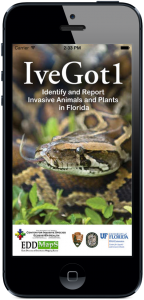
Map and identify invasives with “IveGot1”
Digital devices have proliferated like kudzu in July, and new user applications for these devices are as common as armadillos. Untold hours and dollars are being spent by couch potatoes to defend artificial worlds from dragons, zombies and other imaginary invaders.
Meanwhile, real exotic aliens from air potatoes to monitor lizards are invading Florida.
Don’t panic; there is some good news. A group of new applications that can help citizen scientists identify, locate and manage invasive plant and animal species in Florida is available for free.
The first line of defense is identifying and mapping new occurrences of invasive species. Many, if not most, new infestations were established before anyone noticed or cataloged them, and effective control strategies depend on knowing the extent of new infestations.
The Early Detection & Distribution Mapping System (EDDMapS) has been available at http://www.eddmaps.org since 2005. In the words of its developers, Charles Bargeron and David Moorehead of the University of Georgia’s Bugwood Network, the system was designed to: “develop more complete local, state and regional level distribution data of invasive plants, identify “leading edge” ranges of new invasive threats, provide a means of implementing early detection and response, and help corroborate threats and refine invasive plant lists and management priorities.”
“IveGot1” was developed by this same group through a cooperative agreement with the National Park Service in cooperation with the Florida Fish and Wildlife Conservation Commission and the University of Florida Center for Aquatic and Invasive Plants. The application is now available on both Apple and Android operating systems. The app includes invasive plants and animals and allows direct reporting of sightings as well as back ground information on Florida’s most common invasive species.

The impact of wild hogs on the environment is soil erosion, decreased water quality, spread of other invasive plants, damage to agricultural crops, and damage to native plants and animals. Photo by Jennifer Bearden
At least two other apps useful for invasive species management are also available. “Invasive Plants in Southern Forests” is adapted from the US Forest Service book of the same name. This publication is available for download at http://www.srs.fs.usda.gov/pubs/gtr/gtr_srs062, but it’s a big file (33MB). In addition to its ID function, the app includes appropriate control methods for the over 100 invasive trees, shrubs, vines, grasses and forbs described. As of now, this application is only available for the iPhone platform.
The second app is for Florida’s most widespread invasive animal. Although pythons may be our most infamous invasive animal, they don’t have the distribution of the wild hog. “Squeal on Pigs” combines a location app and educational information to support states’ efforts to control wild hog populations and reduce their impacts on streams and crops.
Maybe you won’t reach Destroyer level in the real battle on air potatoes and Florida’s other invasive species, but moving from Angry Birds to Squeal on Pigs will raise your power level as a Friend of Real Florida.
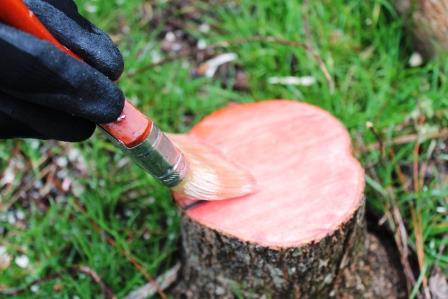
by Mark Mauldin | Feb 20, 2014
As Floridians we often struggle to find any upside to these cold, gray days we’ve been experiencing past few months. As “unfloridian” as our winters can be they pale in comparison to those endured by the more northern states. In fact, the last days of winter can be the ideal time of year in the Panhandle to tackle some outdoor chores like controlling unwanted trees and other woody plants.
Controlling trees can be hard work, the cooler temperatures can make the task a little less taxing. The relative inactivity of the “creepy crawlies” and pests often found in wooded areas is another reason to consider completing tree and woody plant removal projects during the winter.
Tree control generally involves mechanical removal. In some cases mechanical removal provides only short term control; in other cases it can actually increase the number of unwanted plants over time. This is the problem with both Chinese tallow (popcorn tree) and privet. Herbicide treatments can eliminate the possibility of regrowth and provide permanent control. The herbicide application techniques used to control trees and other woody plants are very selective and they are effective during the winter. These techniques provide opportunities to use herbicides in a controlled and very targeted manner with very little risk to surrounding plants. Additionally, the techniques below are most effective through the fall and winter when sap flow in trees is lessened.
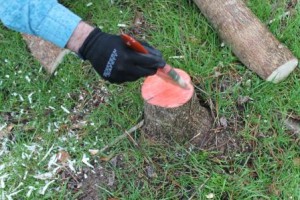
For best results the cut stump treatment should be done immediately after the tree has been cut down. Photo courtesy of Mark Mauldin.
The cut stump technique is a fairly common and very effective method of achieving permanent control of woody plants. As the name implies, the first step in the cut stump technique is to cut down the tree. Immediately after cutting down the tree spray or paint the stump with herbicide. On smaller stumps the entire surface should be covered with herbicide; on larger stumps effective control can be achieved by only covering the outside three inches of the stump.
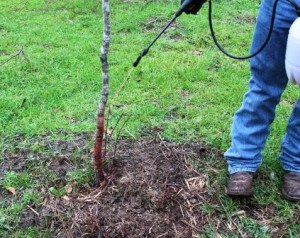
With the basal treatment, cover the bottom 12 to 18 inches of the tree with the herbicide oil mixture. Be sure to cover the entire circumference of the tree. Photo courtesy of Mark Mauldin.
Two additional herbicide application techniques that work well on woody plants do not require the plants to be cut down first. The basal application technique works best on smooth barked woody plants with a diameter of less than six inches. This technique involves spraying the bottom 12 to 18 inches of the tree with an herbicide oil mixture.
The hack and squirt method works well on large and/or thick barked trees. This technique involves using hatchet or other tool to cut through the bark around the circumference of the tree, then applying herbicide directly to the cut. Several months should pass between herbicide application using either of these techniques and mechanical removal.
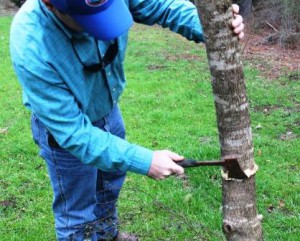
The hack and squirt treatment is best for large and/or thick barked trees. Photo courtesy of Mark Mauldin.
Be sure to read and follow the label of any herbicide you use. Always wear the proper personal protective equipment. For more information on the techniques described, including recommended herbicides and rates, read Herbicide Application Techniques for Woody Plant Control or contact your county’s UF/IFAS Extension Office.
by | Jan 3, 2014
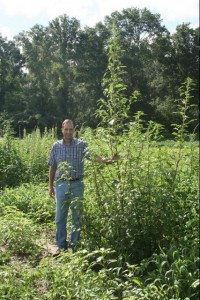
Palmer amaranth can reach heights up 10 feet and signal real trouble for hunters, farmers, and land managers. Loaded with numerous small seeds, mature plants and “offspring” are difficult to control. Photo Courtesy of University of Florida / IFAS
Deer feeders are common in North Florida, and “deer corn” is sold in multiple markets. Cross-roads convenience stores sell it in plain brown bags and big box stores in town sell it in camouflage bags with three color pictures of giant bucks on the front. With the high price of corn in 2012, many hunters saved a few dollars buying “combine run” corn from local farmers or corn screenings from grain elevators. The corn’s no different, however, either product can contain weed seed, especially Palmer amaranth. These weeds can mean big trouble for farmers and hunters.
Palmer amaranth is a species of pig weed, but it’s not your granddaddy’s “careless weed”. It’s taller than either red root pigweed or spiny pigweed, and is becoming resistant to several herbicides, most notably glyphosate (“Roundup”). Amaranth seed are small and plentiful (1 to 1.5 millimeters in diameter) and easily can fit in the nooks and crannies of grain harvesting and handling equipment.
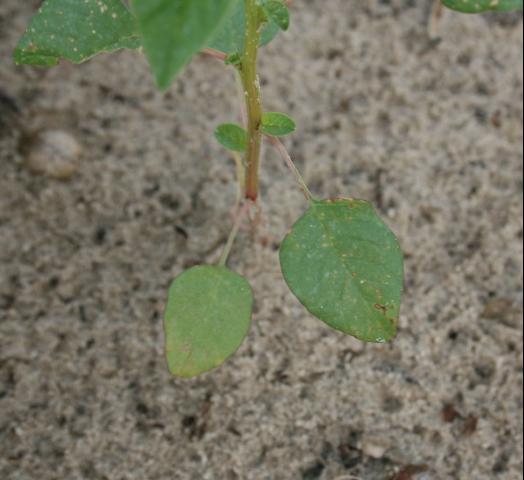
Palmer amaranth first true leaves have small notches on the end and can serve as an identifying characteristic. Photo Courtesy of University of Florida / IFAS.
Once Palmer amaranth seed make it into a deer feeder, there’s a huge opportunity for seedlings to take root in places under the radar of typical scouting and control measures. If these seedlings are herbicide resistant, you’ve done far more harm to the landowner than any savings on corn cost can offset. Conservative estimates indicate herbicide costs have at least doubled due to herbicide resistant weeds. Do your local farmer a real favor; scout and control weeds coming from your deer feeder.
Further information on identifying and controlling Palmer amaranth is available from your county Extension agent or at http://edis.ifas.ufl.edu/ag346
Feeding corn to deer and turkey is permitted by the Florida Fish and Wildlife Conservation Commission as long as the following restrictions are met. “Resident game and wild hogs may be hunted in proximity of year-round game-feeding stations on private lands, provided the feeding station has been maintained with feed for at least six months prior to taking resident game,” and “Wild turkey may not be taken if the hunter is less than 100 yards from a game feeding station when feed is present.” See General Information regarding Feeding Game at http://myfwc.com/hunting/regulations/general-information








